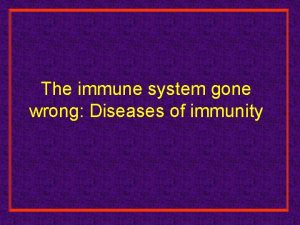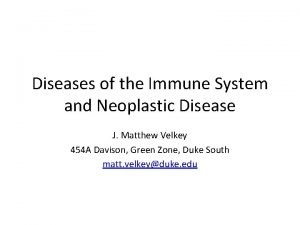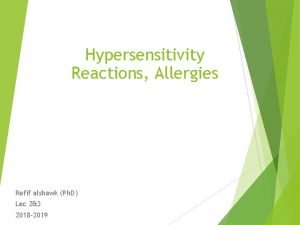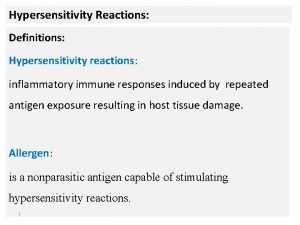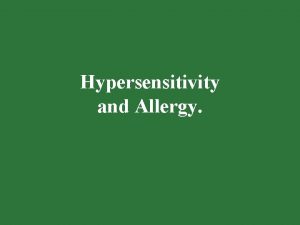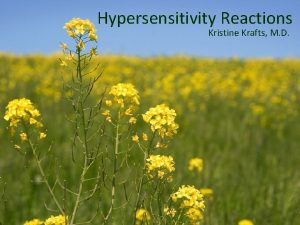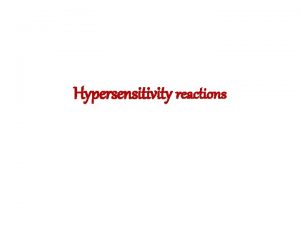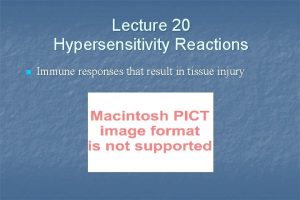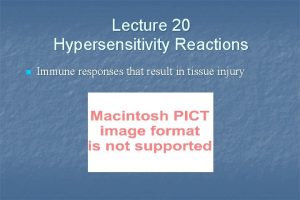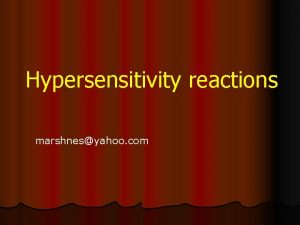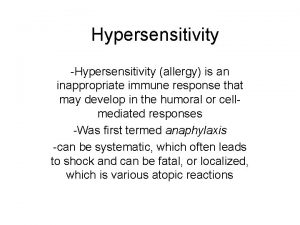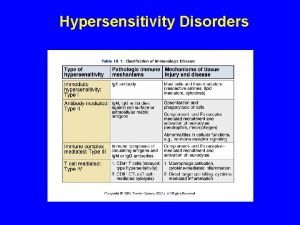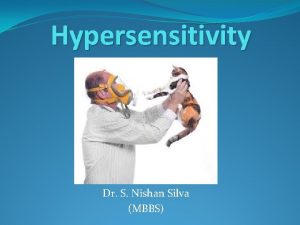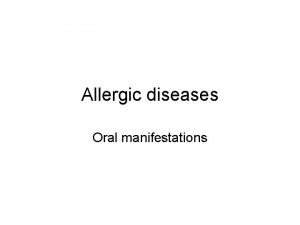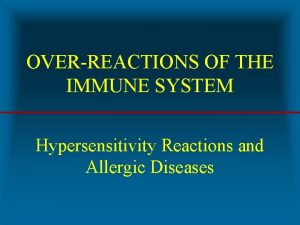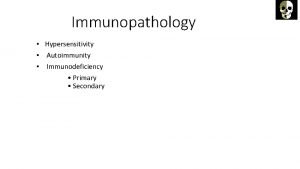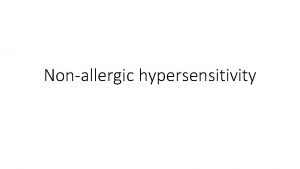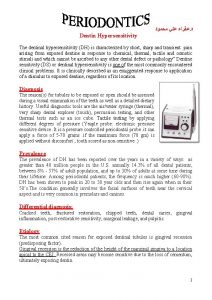Lecture 7 Hypersensitivity Reactions n Immune responses that

















- Slides: 17

Lecture 7 Hypersensitivity Reactions n Immune responses that result in tissue injury

Immune-mediated hypersensitivity reactions n n n Type I - Anaphylactic/Atopic Type II - Cytotoxic Type III - Toxic Complex Type IV - T-cell mediated Type V- Stimulatory

Immune-Mediated Hypersensitivities

Anaphylactic/Atopic Hypersensitivity (Type I )

Atopy n Describes the clinical features of individuals who develop Type I hypersensitivity n n n increased vascular permeability local edema itching Strong hereditary linkages Mediated by a serum factor termed "reagin" "Wheal and flare" reaction

Immediate and Late-Phase Reactions Wheal-and-flare reaction (lasts up to 30 min post injection) Late-phase reaction (develops approximately eight hours later and persists several hours)

Ig. E response is a local event n site of allergen entry n local synthesis results in sensitization of local mast cells n spillover of Ig. E enters circulation and sensitizes mast cells and basophils systemically

Characteristics of Ig. E n Heat labile Fc binding destroyed by heating at 56°C for 30 min n antigen binding is not lost n n Half-life serum half-life is 2 1/2 days (Ig. G is 21 days) n mast cell bound half-life is 12 weeks n

Ig. E Levels in Disease n n n Normal levels do not preclude atopy 30% of random population allergic to at least one common allergen Genetic background puts individual at risk family history indicates predisposition for atopy n cannot predict specific reactions(s) n higher level of Ig. E associated with increased risk of atopy n

Mast Cell Activation/Degranulation Antigen Ig. E Fc Receptor

Contents of the Mast Cell Granules Active agent Histamine Heparin Serotonin SRS-A Chymase Hyaluronidase Eos. Chem. Factor Neut. Chem. Factor Platelet Agg. Factor Activity Increases vascular permeability; elevates level of cyclic AMP Anticoagulation Increases vascular permeability; causes contraction of human broncholes Proteolysis Increases vasuclar permeability Chemoattraction of eosinophils Chemoattraction of neutrophils Aggregates platelets

Comparison of Ig. E and Ig. G 1 Structure n n heavy chain domains 5 vs. 4 mol. wt. 188, 000 vs. 146, 000 carbohydrate 12% vs. 2 -3% half-life (serum) 2 1/2 vs. 21 d

Risk of allergy: Family 50 40 percent of children with atopy 30 20 10 0 none both number of parents with history of allergy

Risk of allergy: Ig. E Levels 100 Percent of subjects 80 60 40 20 0 <60 60 -200 200 -450 >450 % of population with given Ig. E concentration % of subjects with that Ig. E concentration who are atopic

T Cell Control of the Ig. E Response Thymectomy antigen Ts cells 8 specific Ig. E (arbitrary units) 6 4 2 control 0 -1 0 1 2 Weeks 3 4 5

Hyposensitization Allergen injections Symptoms Ig. G Activity Lymph. Trans. Ig. E Time

Clinical Tests for Allergy n Skin Tests Immediate Response (wheal & flare reaction; 20 min) n increased vascular permeability n local edema n itching n Late Reactions (5 -24 hr) n n RAST (Radio Allergo Sorbant Test)
 A subsequent
A subsequent Delayed type hypersensitivity reactions
Delayed type hypersensitivity reactions Delayed type hypersensitivity reactions
Delayed type hypersensitivity reactions Refifs
Refifs Section 2 classifying chemical reactions
Section 2 classifying chemical reactions Chemical reactions section 3 reactions in aqueous solutions
Chemical reactions section 3 reactions in aqueous solutions Section 2 classifying chemical reactions worksheet answers
Section 2 classifying chemical reactions worksheet answers Chemistry unit 5 reactions balancing reactions worksheet
Chemistry unit 5 reactions balancing reactions worksheet Redox half reactions
Redox half reactions Chiến lược kinh doanh quốc tế của walmart
Chiến lược kinh doanh quốc tế của walmart Sau thất bại ở hồ điển triệt
Sau thất bại ở hồ điển triệt Block nhĩ thất độ 2 mobitz 2
Block nhĩ thất độ 2 mobitz 2 Hãy nói thật ít để làm được nhiều
Hãy nói thật ít để làm được nhiều Tìm vết của đường thẳng
Tìm vết của đường thẳng Thể thơ truyền thống
Thể thơ truyền thống Tôn thất thuyết là ai
Tôn thất thuyết là ai Thơ thất ngôn tứ tuyệt đường luật
Thơ thất ngôn tứ tuyệt đường luật Gây tê cơ vuông thắt lưng
Gây tê cơ vuông thắt lưng

